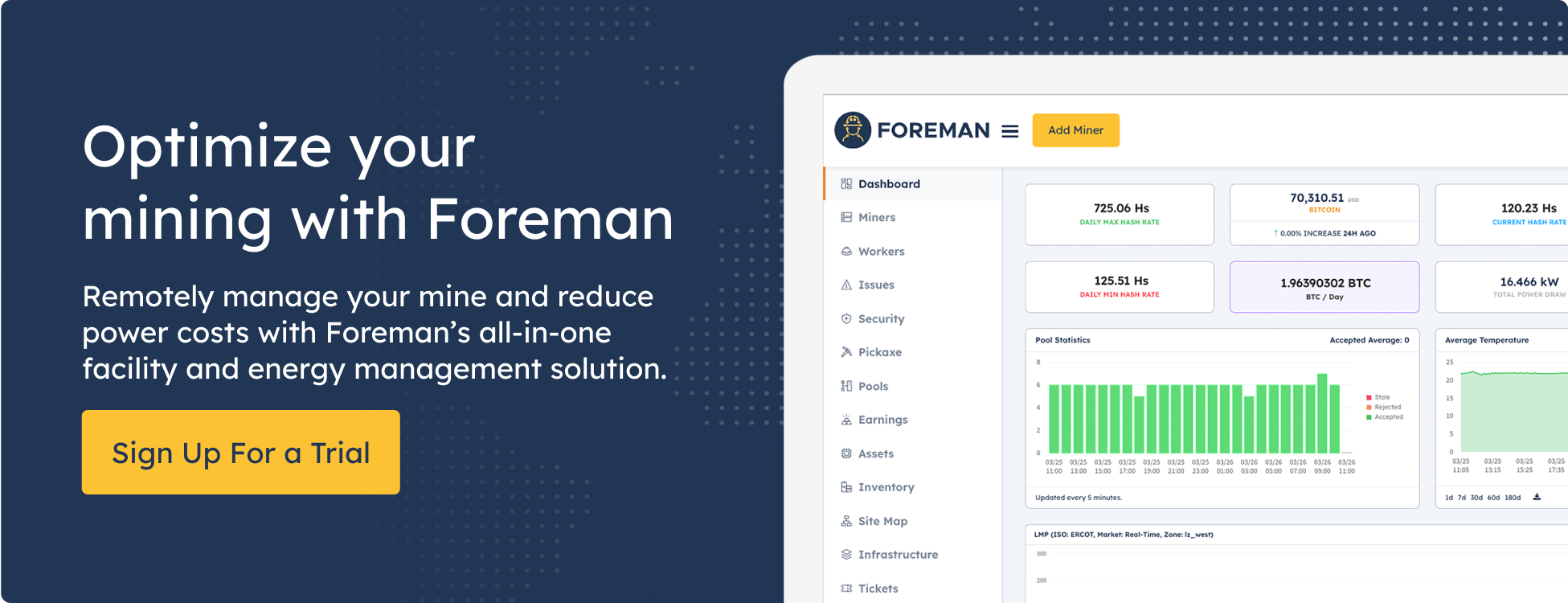Optimizing profitability while managing fluctuating energy costs has always been a central challenge in Bitcoin mining. Traditionally, miners have relied on a single strike price to determine when to curtail operations, shutting down machines when energy costs exceed mining revenues. While this method works in more straightforward energy markets, it might fall short in dynamic environments with multiple machine generations.
To address these challenges, Foreman’s advanced Cost Avoidance feature — Multi-Strike Price Curtailment — provides a more precise solution. This feature allows miners to assign different machine group strike prices, enabling selective curtailment based on profitability. Miners can maximize efficiency and returns by pausing less efficient machines and keeping the most profitable ones operational. Through specific case studies, this article explores the benefits of Foreman’s Multi-Strike Price curtailment, showcasing its impact on Bitcoin mining operations.

Understanding Single-Strike Price and Its Limitations
For the past few years, Bitcoin miners have relied on a strike price—a predefined threshold where electricity costs exceed mining revenue—to determine when to curtail operations. Once energy prices rise above this point, miners shut down their machines to avoid unprofitable mining. This method has proven particularly useful in real-time or hourly electricity markets like ERCOT, where prices fluctuate dramatically throughout the day.
However, using a single strike price across all machines presents limitations. It treats all mining equipment similarly without accounting for performance and energy efficiency differences. This is good when you have a facility with all the same models. Still, in highly dynamic markets, some machines may remain profitable even as others become unprofitable when a single strike price forces a blanket curtailment. As facilities mix older & newer generation machines, this approach can result in missed opportunities to maximize profitability.
Uptime Comparison of Old and New Gen Machines
Since the most recent Bitcoin halving, revenue per block is down 50%. To fight this, new gen machines are delivered, replacing the less efficient ones and pushing hashprice even further. The resulting competition has prompted miners to adapt.
Many operations now manage mixed fleets. Despite the varying efficiency of these machines, operators continue to mine and seek ways to further optimize the fleet's performance.
Foreman’s Multi-Strike Price Curtailment tech allows miners to assign different strike prices based on each machine's performance. Newer, more efficient hardware—like the S21— remains online during higher energy prices, while older, less profitable machines are curtailed when necessary. This strategy ensures that mining operations with diverse fleets maintain profitability even during price spikes.
Estimated Uptime of Mining Machines
The chart above presents the estimated uptime for three generations of mining machines since the 2024 halving within the average hourly ERCOT electricity prices:
Antminer S21 (200Th): Estimated uptime is 98%, with 2% downtime.
Antminer S19 XP (140Th): Estimated uptime is 97%, with 3% downtime.
Antminer S19j Pro (100Th): Estimated uptime is 94%, with 6% downtime.
The figures reveal an evident trend: newer models like the S21 experience significantly less downtime than older models like the S19j Pro. This difference is crucial in high-stakes mining environments, where even a few percentage points of additional uptime can considerably affect overall profitability. It is clear that in this scenario, a single average strike price is not enough.
In this methodology, the analysis estimates based on hourly data. Real-world curtailments may vary depending on period delay settings in Cost Avoidance.
In the chart above, each bubble represents an unprofitable event where energy prices exceeded the machine's ability to mine profitably. Following the halving in April 2024, there was a marked increase in unprofitable events. As a result, older machines were curtailed more frequently, driving a higher utility value for cost avoidance on those machines. Cost Avoidance staves off this un-profitability longer by avoiding those events altogether, extending the life of older machines.
30MW Facility Scenario
When analyzing the average ERCOT load zone (LZ) prices, the total cost avoided per megawatt-year (MW-year) for a mixed fleet can be significant, as demonstrated by the figures above. For a 30MW facility with 10MW allocated per machine type, the estimated cost avoidance amounts to ~$500,000 annually. This is broken down as follows:
Antminer S19j Pro (100Th): ~$220,000, contributing 44% of the total cost avoidance.
Antminer S19 XP (140Th): ~$160,000, accounting for 32% of the total cost avoidance.
Antminer S21 (200Th): ~$120,000, representing 24% of the total cost avoidance.
Older generation machines, such as the S19j Pro, contribute the largest cost savings, primarily through strategic downtime. While these machines experience more curtailment due to their lower efficiency, Multi-Strike Price technology saves operators significant costs by shutting them down when energy prices spike, thereby avoiding unprofitable operations.
In contrast, the newer, more efficient machines like the Antminer S21 maintain more uptime, contributing less overall cost savings through curtailment but delivering consistent profitability by staying online longer. This mixed-fleet strategy ensures that new and older generation machines are utilized optimally, balancing uptime with cost avoidance to achieve the highest possible profitability in dynamic markets like ERCOT.
Foreman’s Multi-Strike Price addition to Cost Avoidance gives Bitcoin miners a more precise tool for managing energy market volatility. By assigning different strike prices to various machine generations, miners can curtail less efficient machines, reducing unprofitability while keeping more profitable equipment running. This strategy not only maximizes uptime but also has the potential to extend the lifespan of older machines by preventing unnecessary operation during energy price spikes. This technology helps miners maintain profitability and adapt to changing conditions in dynamic markets more efficiently.



